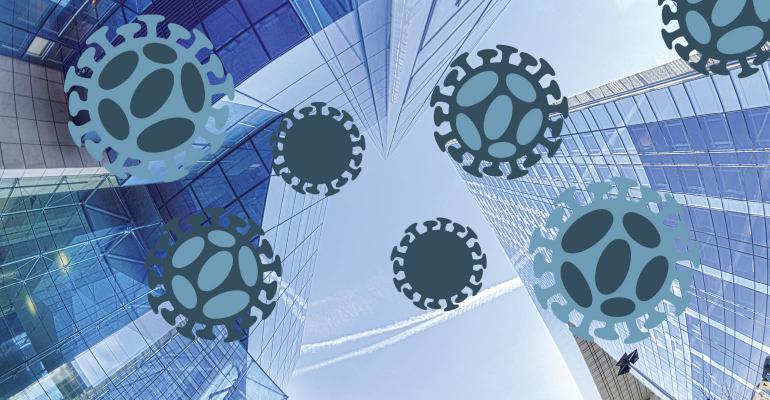The flood of coronavirus information can be paralyzing, but when the crisis hits home with a confirmed COVID-19 exposure in one of your buildings, you need to take action. In the month to come, the number of confirmed cases will grow, as will the likelihood that an infectious individual enters your building. The time to develop a measured response to this situation is now. Once you’ve taken steps to inform and protect your occupants, what can you do to mitigate the situation and get your property ready for re-occupancy?
I posed this question to Ben Jelin, Ph.D., CIH, CSP, who’s worked with several property owners to support re-occupation after a COVID-19 exposure.
Property owners want to know if there’s a test they can order to ensure the COVID-19 virus isn’t present in their building. Is there a test for that?
No, there is currently no commercially available environmental or surface test for COVID-19. The priority is on human testing now.
So, what can they do to provide some assurance to tenants that their spaces have been adequately cleaned and it’s safe to re-enter?
There’s a two-pronged approach: first, make sure your cleaning contractors are consistently using accepted protocols outlined by CDC and industry guidance (make sure to use an EPA-registered antimicrobial/viricidal solution from the N List for disinfection of COVID-19 virus). This is not the same as routine cleaning, which is why engaging a Certified Industrial Hygienist (CIH) or other appropriate safety or infection control professional is helpful. They can help you establish those protocols and train your team. They can also help develop recommendations for appropriate safety gear and personal protective equipment (PPE). Second, test to verify that surfaces have been adequately cleaned. We can use proxy measurements to determine if surfaces have been cleaned according to hospital and industrial food production cleanliness standards.
Can you explain how proxy measurement works?
While we don’t have a test specifically for COVID-19, we do have a way to detect the presence of other microorganisms. The food and hospital industries use a method called ATP measurement to identify and manage risk for bacteriological contamination and determine the need for additional disinfection. Although viruses do not expend energy/use ATP independently, we utilize its measurement as a proxy to determine whether disinfection was adequate up to food and hospital industry standards. Use of this proxy measurement assumes that the EPA-registered disinfectants that have been approved for deactivation of COVID-19 virus also deactivate bacteria and other ATP producing microbes. Therefore, if adequate cleaning and disinfection has occurred, the representative surfaces tested should meet the passing ATP-loading criteria that is integrated into the field measurement system. The results are instant—no waiting for lab results.
Is the ATP testing method widely accepted?
We’re in an unprecedented situation, and it’s the best tool at our disposal right now. We just wrapped up testing at a Florida school with a confirmed case of COVID19. The school district engaged us to conduct ATP sampling following a cleaning event. Our contact with the health department understood and accepted ATP sampling as an effective way to evaluate the cleaning. We interpret that as a validation of our approach under the current circumstances.
Where else have you used this method? Is it useful in other environments?
We’re seeing demand from all different sectors—a bank, a car dealership, and a hotel portfolio are some of the projects we’ve seen this week.
What advice do you have for owners of portfolios who may have to address this issue at multiple sites?
We suggest you create a tiered approach to cleaning that can be generalized to multiple sites and activated as necessary by property managers in coordination with corporate representatives. In some cases, the cleaning can be done by your existing cleaning/janitorial crew, and your approach would entail increases in usual cleaning frequency. In other situations, you may want to engage a professional remediation company with biohazardous materials experience. Consultation with a CIH on a case-by-case basis would be recommended, depending upon the facility exposure to a COVID-19 patient/case. Your plans should also include a protocol for continued cleaning once your buildings are re-occupied.
When hiring a consultant for cleaning protocols and surface testing, what should a property owner look for?
Look for a company with professionals that have demonstrated competence in occupational exposure control and prevention, as well as those that have credentials that show they are bound to uphold ethical practice of occupational hygiene, such as: CIH, Certified Safety Professional (CSP), Certified Hazardous Materials Manager (CHMM), Council-certified Environmental Infection Control Consultant (CEICC) and Indoor Environmentalist/Consultant (CIE/CIEC).





